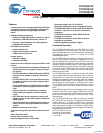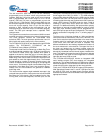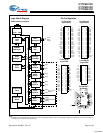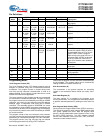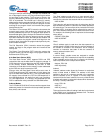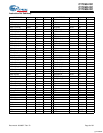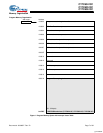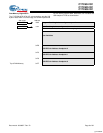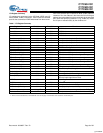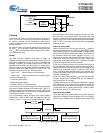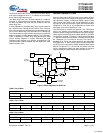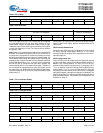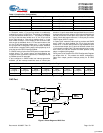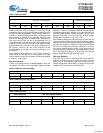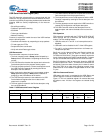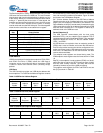
CY7C63413C
CY7C63513C
CY7C63613C
Document #: 38-08027 Rev. *B Page 5 of 32
During an interrupt acknowledge, interrupts are disabled and
the 14-bit program counter, carry flag, and zero flag are written
as two bytes of data memory. The first byte is stored in the
memory addressed by the program stack pointer, then the
PSP is incremented. The second byte is stored in memory
addressed by the program stack pointer and the PSP is incre-
mented again. The net effect is to store the program counter
and flags on the program “stack” and increment the program
stack pointer by two.
The Return From Interrupt (RETI) instruction decrements the
program stack pointer, then restores the second byte from
memory addressed by the PSP. The program stack pointer is
decremented again and the first byte is restored from memory
addressed by the PSP. After the program counter and flags
have been restored from stack, the interrupts are enabled. The
effect is to restore the program counter and flags from the
program stack, decrement the program stack pointer by two,
and re-enable interrupts.
The Call Subroutine (CALL) instruction stores the program
counter and flags on the program stack and increments the
PSP by two.
The Return From Subroutine (RET) instruction restores the
program counter, but not the flags, from program stack and
decrements the PSP by two.
8-bit Data Stack Pointer (DSP)
The Data Stack Pointer (DSP) supports PUSH and POP
instructions that use the data stack for temporary storage. A
PUSH instruction will pre-decrement the DSP, then write data
to the memory location addressed by the DSP. A POP
instruction will read data from the memory location addressed
by the DSP, then post-increment the DSP.
During a reset, the Data Stack Pointer will be set to zero. A
PUSH instruction when DSP equal zero will write data at the
top of the data RAM (address 0xFF). This would write data to
the memory area reserved for a FIFO for USB endpoint 0. In
non-USB applications, this works fine and is not a problem.
For USB applications, it is strongly recommended that the
DSP is loaded after reset just below the USB DMA buffers.
Address Modes
The CY7C63413C/513C/613C microcontrollers support three
addressing modes for instructions that require data operands:
data, direct, and indexed.
Data
The “Data” address mode refers to a data operand that is
actually a constant encoded in the instruction. As an example,
consider the instruction that loads A with the constant 0xE8:
• MOV A,0E8h
This instruction will require two bytes of code where the first
byte identifies the “MOV A” instruction with a data operand as
the second byte. The second byte of the instruction will be the
constant “0xE8”. A constant may be referred to by name if a
prior “EQU” statement assigns the constant value to the name.
For example, the following code is equivalent to the example
shown above:
• DSPINIT: EQU 0E8h
• MOV A,DSPINIT
Direct
“Direct” address mode is used when the data operand is a
variable stored in SRAM. In that case, the one byte address of
the variable is encoded in the instruction. As an example,
consider an instruction that loads A with the contents of
memory address location 0x10:
• MOV A, [10h]
In normal usage, variable names are assigned to variable
addresses using “EQU” statements to improve the readability
of the assembler source code. As an example, the following
code is equivalent to the example shown above:
• buttons: EQU 10h
• MOV A,[buttons]
Indexed
“Indexed” address mode allows the firmware to manipulate
arrays of data stored in SRAM. The address of the data
operand is the sum of a constant encoded in the instruction
and the contents of the “X” register. In normal usage, the
constant will be the “base” address of an array of data and the
X register will contain an index that indicates which element of
the array is actually addressed:
• array: EQU 10h
•MOV X,3
• MOV A,[x+array]
This would have the effect of loading A with the fourth element
of the SRAM “array” that begins at address 0x10. The fourth
element would be at address 0x13.
[+] Feedback



